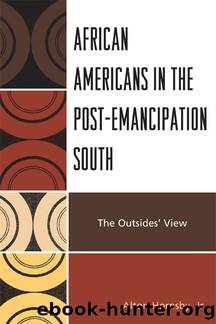African Americans in the Post-Emancipation South by Alton Hornsby Jr

Author:Alton Hornsby Jr. [Hornsby]
Language: eng
Format: epub
Publisher: UPA
Published: 2010-01-15T00:00:00+00:00
Notes
1. Alan-Olney, The New Virginians, II, 262; I, 246, 231â234.
2. Brooks, Petals Plucked From Sunny Climes, 374â376; Hogan, International Review, VIII, 111; Freeman, Some Impressions of the United States; Hole, A Little Tour in America, 286.
3. Saunders, Through the Light Continent, 79, 83â85; Sala, American Revisited, 191; DâHaussonville, A Travers, Les Stas-Unis, 158; Wiley, Arena, XXIII, 555.
4. Saunders, Through the Light Continent, 79, 83â85; Campbell, White and Black, 131, Sala, America Revisited, 191; Barbour, Florida for Tourist, 237; Langdon, Political Science Quarterly, VI, 35; Bryce, American Commonwealth, 521.
5. In this connection it is ironic that Hayes should have been the architect of the policy, which, if Professor Loganâs estimate is correct, helped to send the Negroes to their nadir; Ibid., 24â25; Diary and Letters of Rutherford Birchard Hayes, Nineteenth President of the United States, (ed. By Charles Richard Williams; Columbus, Ohio: The Ohio State Archaeological and Historical Society, 1924), III, 621.
6. Brooks, Petals Plucked from Sunny Climes, 374â376.
7. Du Bois, United States Department of Labor Bulletin, III, No. 14, pp. 12â13.
8. Du Bois, âA Negro Schoolmaster in the New South,â Atlantic Monthly, LXXXIII, 100â101.
9. Towne, Letters and Diary, 281, 295â297.
10. Cooley, School Acres, 69.
11. Wyman, New England Magazine, III, 793â794.
12. One should not allow the designations âcollegeâ and âuniversityâ obscure the fact that most African American institutions attempted to offer work on the âsecondary levelâ and almost all had ânormalâ departments.
13. Campbell, White and Black, 275â276; Bryce, American Commonwealth, II, 519.
14. Barrows, Atlantic Monthly, LXVIII, 811â812.
15. Thomas J. Callaway, âThe President at Atlanta and Tuskegee,â Harperâs Weekly, XLII (December, 1898), 1300.
16. Saunders, Through the Light Continent, 86â87; Harley, Southward Ho!, 130.
17. Gibbs, Shadow and Light, 369.
18. Fortune, Black and White, 81, 86â87; Gibbs, Shadow and Light, 369.
19. Brown, My Southern Home, 213â217; Aubrey, Fortnightly Review, XLIII, n. s., 861.
20. Barrows, Atlantic Monthly, LXVII, 811â812.
21. Freeman, Some Impressions of the United States, 141â146; Hogan, International Review, VIII, III; Brown, My Southern Home, 212; William Edwin Adams, Our American Cousins: Being Personal Impressions of the People and Institutions of the United States (London: Walter Scott, 1883), 290. Adams, a writer for the New Castle Weekly Chronicle, was in the South during 1881â1882. Thomas D. Clark in Clark, ed. Travels in the New South, I, 137.
22. W. E. B. Du Bois, âThe Relation of the Negroes to the Whites in the South,â Annals of the American Academy of Political and Social Sciences, XVIII (July, 1901), 134.
23. Adams, Studies, Military and Diplomatic, 230â231.
24. Kelsey, The Negro Farmer, 42, 61â62.
25. Baker, Following the Color Line, 53â54.
26. Hart, The Southern South, 311â314, 317â318.
27. Johnston, The Negro in the New World, 396, 399, 409; Cooley, School Acres, 53.
28. Huret, En Amerique, 385â407.
29. DâEstournelles de Constant, America and Her Problems, 364â367; Kelsey, The Negro Farm, 731; Munsterberg, The Americans, 170â172, 181â182. Johnston, The Negro in the New World, 404â419.
30. Archer, Through Afro-America, 47, 106, 108â110, 112â113, 117â125.
31. Du Bois, Dusk of Dawn, 69, 77, 93.
32. Edward T. Ware, âHigher Education of Negroes in the
Download
This site does not store any files on its server. We only index and link to content provided by other sites. Please contact the content providers to delete copyright contents if any and email us, we'll remove relevant links or contents immediately.
Cecilia; Or, Memoirs of an Heiress — Volume 1 by Fanny Burney(31447)
Cecilia; Or, Memoirs of an Heiress — Volume 3 by Fanny Burney(31037)
Cecilia; Or, Memoirs of an Heiress — Volume 2 by Fanny Burney(30985)
The Great Music City by Andrea Baker(23001)
We're Going to Need More Wine by Gabrielle Union(18126)
Bombshells: Glamour Girls of a Lifetime by Sullivan Steve(13158)
Pimp by Iceberg Slim(13000)
All the Missing Girls by Megan Miranda(12838)
Fifty Shades Freed by E L James(12492)
Talking to Strangers by Malcolm Gladwell(11991)
Norse Mythology by Gaiman Neil(11962)
Crazy Rich Asians by Kevin Kwan(8412)
Mindhunter: Inside the FBI's Elite Serial Crime Unit by John E. Douglas & Mark Olshaker(7898)
The Lost Art of Listening by Michael P. Nichols(6534)
Enlightenment Now: The Case for Reason, Science, Humanism, and Progress by Steven Pinker(6449)
Bad Blood by John Carreyrou(5816)
The Four Agreements by Don Miguel Ruiz(5577)
Weapons of Math Destruction by Cathy O'Neil(5096)
We Need to Talk by Celeste Headlee(4920)
